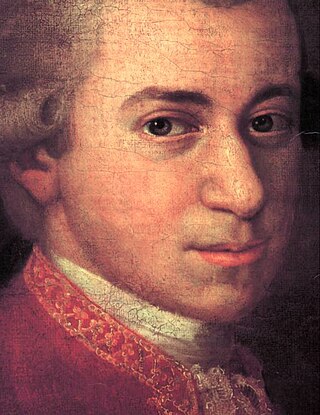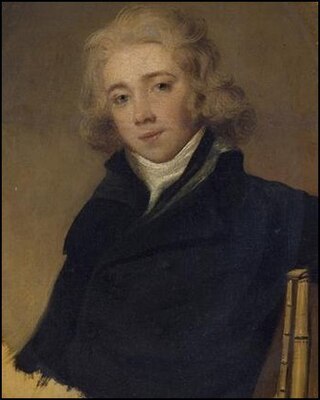
Picciola serenata (little serenade) in B-flat major is a serenade written by Italian composer Antonio Salieri scored for five instruments: 2 oboes, 2 horns and 1 bassoon. The piece was composed in 1778 and consists of four movements.

Picciola serenata (little serenade) in B-flat major is a serenade written by Italian composer Antonio Salieri scored for five instruments: 2 oboes, 2 horns and 1 bassoon. The piece was composed in 1778 and consists of four movements.
Salieri wrote Picciola serenata in 1778. The piece was written at the beginning of his Italian tour, and shortly after he had been appointed the director of the Italian opera in 1774. Salieri's success as a composer was approaching its peak, as his music quietly faded in popularity into the beginning of the 1800s.
It was not until the 20th century that Salieri resurged in popularity because of the depiction of Salieri in Peter Shaffer's 1979 play Amadeus , which was later adapted into the film of the same name.
Picciola serenata is scored for 2 oboes, 2 horns and 1 bassoon.
The serenade is in four movements as follows:
The opening movement begins with a stately entrance in B-flat major in which the two oboes present the motive while the bassoon and two horns provide a strong foundation of the tonic chord on the downbeat. In measure 25, the piece modulates to F major, using the same material from the opening. The piece uses strong use of the tonic and dominant chord.
Keeping with the exalted feel of the first movement, the second movement opens with the melody in the horn, the other instruments accompanying with eighth notes in a 6/8 meter. The majority of this movement is in F major, usually and often modulating to the dominant key of C major. The movement ends in the key of F major.
The third movement is a minuet in 3/4, which is very common for a four movement serenade. The movement's tonal center is B-flat major. This movement takes many harmonic and melodic elements from the first two, namely the frequent modulation to the tonic key and chromatic passing tones. Similar to the first movement and unlike the second, the piece uses first and second oboes to carry most of the melodic content, while the horns and bassoon provide harmony and counterpoint.
The fourth movement, 'Presto', is the final movement of the piece. Again, we see a lot of the same compositional devices being used here. It frequently plays within the tonic or dominant triad. Towards the end of the movement, there is a cadenza in the first oboe all centered around the V chord of F major, after which the piece returns to the opening material of the movement, ending in B-flat major.

The Piano Concerto No. 2 in B♭ major, Op. 83, by Johannes Brahms is separated by a gap of 22 years from his first piano concerto. Brahms began work on the piece in 1878 and completed it in 1881 while in Pressbaum near Vienna. It took him three years to work on this concerto, which indicates that he was always self-critical. He wrote to Clara Schumann: "I want to tell you that I have written a very small piano concerto with a very small and pretty scherzo." Ironically, he was describing a huge piece. This concerto is dedicated to his teacher, Eduard Marxsen. The public premiere of the concerto was given in Budapest on 9 November 1881, with Brahms as soloist and the Budapest Philharmonic Orchestra, and was an immediate success. He proceeded to perform the piece in many cities across Europe.

Symphony No. 2 in D major, Op. 73, was composed by Johannes Brahms in the summer of 1877, during a visit to Pörtschach am Wörthersee, a town in the Austrian province of Carinthia. Its composition was brief in comparison with the 21 years it took him to complete his First Symphony.

The Symphony No. 1 in C minor, Op. 68, is a symphony written by Johannes Brahms. Brahms spent at least fourteen years completing this work, whose sketches date from 1854. Brahms himself declared that the symphony, from sketches to finishing touches, took 21 years, from 1855 to 1876. The premiere of this symphony, conducted by the composer's friend Felix Otto Dessoff, occurred on 4 November 1876, in Karlsruhe, then in the Grand Duchy of Baden. A typical performance lasts between 45 and 50 minutes.
The two Serenades, Op. 11 and 16, represent early efforts by Johannes Brahms to write orchestral music. They both date from after the 1856 death of Robert Schumann when Brahms was residing in Detmold and had access to an orchestra.
The Piano Sonata No. 18 in E♭ major, Op. 31, No. 3, is an 1802 sonata for solo piano by Ludwig van Beethoven. A third party gave the piece the nickname "The Hunt" due to one of its themes' resemblance to a horn call. Beethoven maintains a playful jocularity throughout much of the piece, but as in many of his early works, the jocular style can be heard as a facade, concealing profound ideas and depths of emotion.
Symphony No. 93 in D major, Hoboken I/93, one of the twelve London symphonies written by Joseph Haydn.

The Serenade No. 10 for winds in B-flat major, K. 361/370a, is a serenade by Wolfgang Amadeus Mozart scored for thirteen instruments: twelve winds and string bass. The piece was composed in 1781 and is often known by the subtitle Gran Partita, though the title is a misspelling and not in Mozart's hand. It consists of seven movements.
The Quintet in E♭ major for Piano and Winds, K. 452, was composed by Wolfgang Amadeus Mozart, who entered it in his thematic catalogue of his works on March 30, 1784. It was premiered two days later at the Imperial and Royal National Court Theater in Vienna. Shortly after the premiere, Mozart wrote to his father that "I myself consider it to be the best thing I have written in my life." It is scored for piano, oboe, clarinet, horn and bassoon. Sarah Adams notes that "The four dissimilar wind timbres pitted against the piano in this extraordinary work must have posed Mozart with a compositional challenge. He contended with the instrumental balance by constructing themes easily divisible into small motifs and by changing textural groupings every few bars for a kaleidoscopic array of tone colours."
Michael Haydn's Symphony No. 29 in D minor, Opus 1 No. 3, Perger 20, Sherman 29, MH 393, written in Salzburg in 1784, is the only minor key symphony he wrote. It is the first of four D minor symphonies attributed to Joseph Haydn.

Hyacinthe Jadin was a French composer who came from a musical family. His uncle Georges Jadin was a composer in Versailles and Paris, along with his father Jean Jadin, who had played bassoon for the French Royal Orchestra. He was one of five musical brothers, the best known of whom was Louis-Emmanuel Jadin.
The Op. 33 String Quartets were written by Joseph Haydn in the summer and Autumn of 1781 for the Viennese publisher Artaria. This set of string quartets has several nicknames, the most common of which is the "Russian" quartets, because Haydn dedicated the quartets to the Grand Duke Paul of Russia and many of the quartets were premiered on Christmas Day, 1781, at the Viennese apartment of the Duke's wife, the Grand Duchess Maria Feodorovna. Some scholars theorize that the "Russian" quartets were the inspiration for Mozart's six string quartets dedicated to Haydn, but no direct evidence has been found.
An organ concerto is an orchestral piece of music in which a pipe organ soloist is accompanied by an an orchestra, although some works exist with the name "concerto" which are for organ alone.

The Serenade for Orchestra No. 9 in D major K. 320, Posthorn, was written by Wolfgang Amadeus Mozart in Salzburg, in 1779. The manuscript is dated 3 August 1779 and was intended for the University of Salzburg's "Finalmusik" ceremony that year.

Symphony No. 35 in B♭ major, Hoboken I/35, was written by Joseph Haydn. The autograph score is "carefully" dated "December 10, 1767". It has been speculated that this symphony was written to celebrate Prince Esterházy's return from a visit to the Palace of Versailles.

The Symphony No. 20 in C major is a festive symphony by Joseph Haydn. Hodgson places the composition date in either 1761 or 1762 while Brown states that it was likely composed before 1761. Calvin Stapert affirmatively states that it was composed in the group of 15 symphonies within Haydn's tenure with Count Morzin. And is festive, like C major Symphonies 32, 33, and 37. It is scored for 2 oboes, bassoon, 2 horns, 2 trumpets, timpani, strings and continuo. The symphony is in four movements:

The Concerti grossi, Op. 3, HWV 312–317, are six concerti grossi by George Frideric Handel compiled into a set and published by John Walsh in 1734. Musicologists now agree that Handel had no initial knowledge of the publishing. Instead, Walsh, seeking to take advantage of the commercial success of Corelli's Concerti grossi, Op. 6, simply combined several of Handel's already existing works and grouped them into six "concertos".

The Oboe Concerto in E-flat major is an oboe concerto by Vincenzo Bellini, most likely composed in 1823. Bellini's only surviving concerto, the piece is also an important part of his limited instrumental output. Performances typically last between seven and eight minutes.
The divertimenti in F major, B-flat major, E-flat major, F major, and B-flat major are five companion compositions for pairs of oboes, horns and bassoons by Wolfgang Amadeus Mozart.